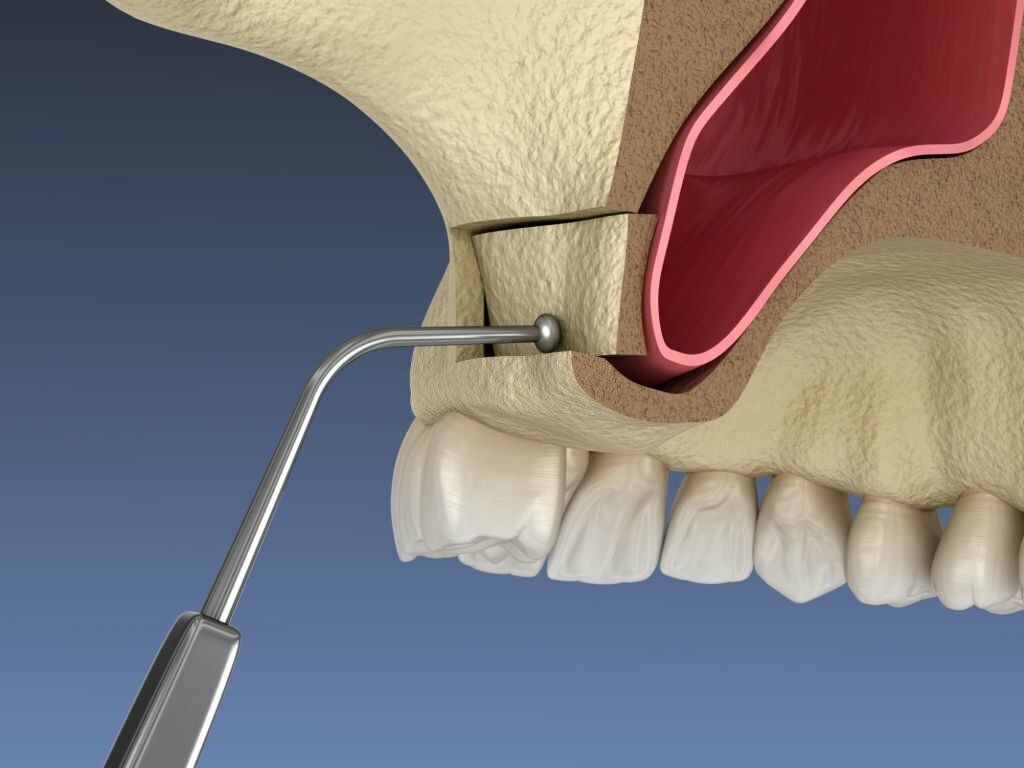This article is reviewed, corrected, and approved by: Dr. Benjamin McLean M.D. | FCPS | FRCP | MPH
Sinus lift surgery is a specialized dental procedure targeted at enhancing the size of bone in the top jaw. Specifically, the area of the premolars and molars by lifting the sinus membrane. This surgery is crucial for patients who wish to receive dental implants in the upper jaw but have insufficient bone volume.
So, let's delve into sinus lift implants. What it involves, who it's for, its risks and benefits, and alternative treatments.
What is Sinus Lift Surgery?
-People commonly known sinus augmentation as sinus lift surgery. It is a dental operation that elevates the sinus membrane to create space for additional bone material in the upper jaw.
This surgery becomes essential when the natural bone in the upper jaw has deteriorated. Making it impossible to place dental implants securely.
Who Needs Sinus Lift Surgery?
We recommend Sinus Augmentation for persons who meet the following criteria:
- Inadequate Bone Volume: Candidates must have insufficient bone height in the upper jaw. It needs to support dental implants.
- Healthy Sinuses: Good sinus health is a vital part of the success of the procedure. Patients with sinus issues may need to address those problems before undergoing a sinus lift.
- Non-smokers: Smoking can hinder or slow down the healing process. It could increase the risk of complications. Doctors often advise candidates to quit smoking prior to the surgery.
- Overall Health: Candidates should be in good health, with any chronic medical disorders under control.
- Patient Commitment: Patients must commit to postoperative care. Which includes rest and avoiding activities that may disrupt healing.
Risks and Benefits of Sinus Lift Surgery
Before opting for sinus lift surgery, it is essential that you know its potential hazards and advantages.
Risks
- Infection: As with any surgical procedure, there is always a risk of infection. Learn more about sinus infections from here: Are Sinus Infections Contagious?
- Sinus Issues: While rare, there is a possibility of sinus complications.
- Graft Failure: The new bone material may not integrate successfully.
- Pain and Swelling: After sinus lift surgery swelling is a common issue.
Benefits
- Dental Implant Support: Sinus lift surgery makes it possible to receive dental implants. Which can restore chewing function and aesthetics.
- Improved Bone Density: The surgery enhances bone density in the upper jaw.
- Long-term Solution: Dental implants placed after a successful sinus lift can last a lifetime.
- Enhanced Confidence: Restored dental function and appearance boost self-confidence.
Sinus Augmentation: A Step-by-Step Overview
Preoperative Preparation
- Consultation with a specialist.
- When it comes to checking bone density, doctors often use X-rays and CT scans. These tests help them get a good idea of the condition of their bones.
- Another important step is to discuss your medical history and any medications you might be taking. It's useful for doctors to know this information as it can provide valuable insights into your overall health. To the best course of action.
- Plan the surgery, including the choice of bone graft material (autograft, allograft, xenograft).
Step-by-Step Procedure
- Anesthesia: The patient's comfort is ensured with local or general anesthesia.
- Incision: The surgeon cuts the gum tissue to reach the jawbone.
- Lifting the Sinus Membrane: To put the bone graft, the sinus membrane is gently lifted.
- Bone Graft Placement: The new space has bone graft material.
- Closure: The incision is sutured.
- Healing Time: Patients are given time for the bone to integrate with existing bone. This is a process that may take several months.
Postoperative Care
- Pain management through prescribed medications.
- A soft diet to avoid stressing the surgical site.
- Strict adherence to postoperative care instructions.
- Avoidance of smoking and certain activities.
Recovery After Sinus Augmentation: What to Expect?

Here are some crucial factors that are a necessary part of a sinus lift implant. Some of those
Pain Management
- Discomfort and swelling are common but manageable with prescribed pain relievers.
- Follow the surgeon's recommendations for pain management.
Diet and Oral Hygiene
- Stick to a soft diet for a specified period.
- Follow strict oral hygiene to prevent infection.
Follow-up Care
- Patients must have follow-up visits on consultations to track healing progress.
- The surgeon determines the bone is adequately integrated before placing the dental implant.
Recovery is the utmost priority for those who go through surgery. Deley recovery indicates there might be some complications there. Monitoring progress through sinus lift surgery before and after pictures and consulting with an expert periodontist can be helpful.
Alternatives to Sinus Lift Surgery
Dental Implants in Other Areas of the Mouth: Some other patients have sufficient bone in areas of the mouth where dental implants can be placed.
Removable Dentures: People who can't or don't want to undergo surgery can get traditional removable dentures.
Bridgework: Dental bridges can replace missing teeth without the need for implants.
Final Thoughts
Sinus lift implant could be a valuable procedure for individuals with insufficient bone in the upper jaw. Those who desire dental implants. You need to recognize associated risks, benefits, and other options before deciding.
Before going through any surgery, you must justify its pros and cons. Does it suit you, or is it the best fit for you or not? A periodontist can assist you in this matter.
Summary of Key Points
Dentists perform sinus lift surgery to increase bone volume in the upper jaw, enabling dental implant placement.
Candidates should have insufficient bone volume, good sinus health, and be in good overall health.
Risks include infection, sinus complications, graft failure, and postoperative discomfort.
Benefits include dental implant support, improved bone density, and a long-term solution.
The procedure involves anesthesia, incision, lifting of the sinus membrane, bone graft placement, and closure.
Postoperative care and strict adherence to instructions are essential for successful recovery.
Alternatives to sinus lift implant include implants in other areas, removable dentures, and bridgework.
F.A.Q
Q: How much is sinus surgery cost?
Ans: In the US, a sinus augmentation cost is around $3000 to $12,000.
Q: How painful is a sinus lift procedure?
Ans: The sinus lift procedure is usually done under local anesthesia. You may feel some pressure or movement but not pain.


